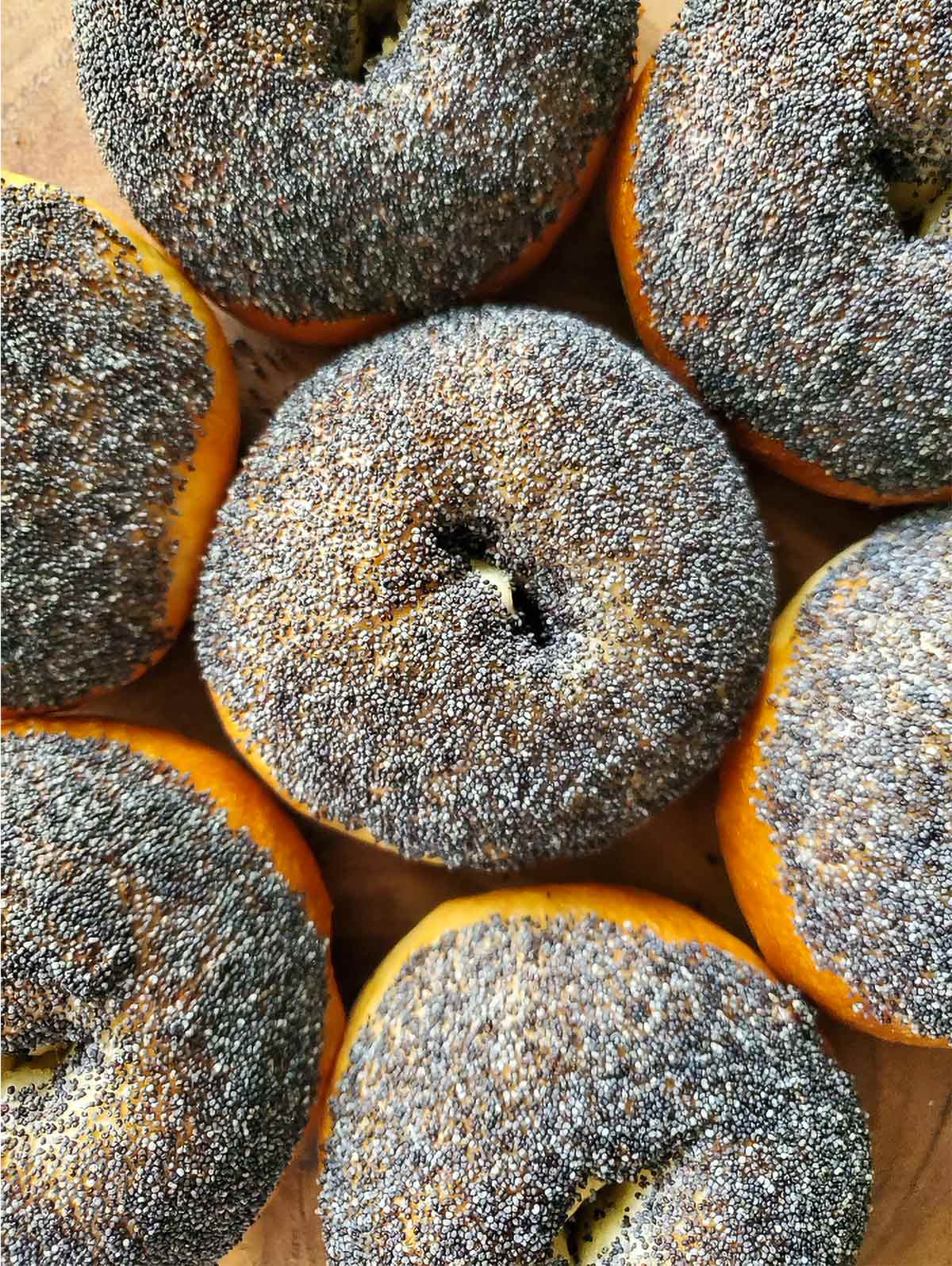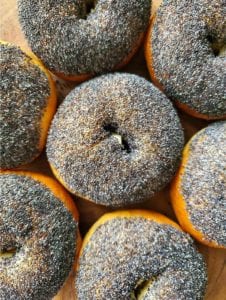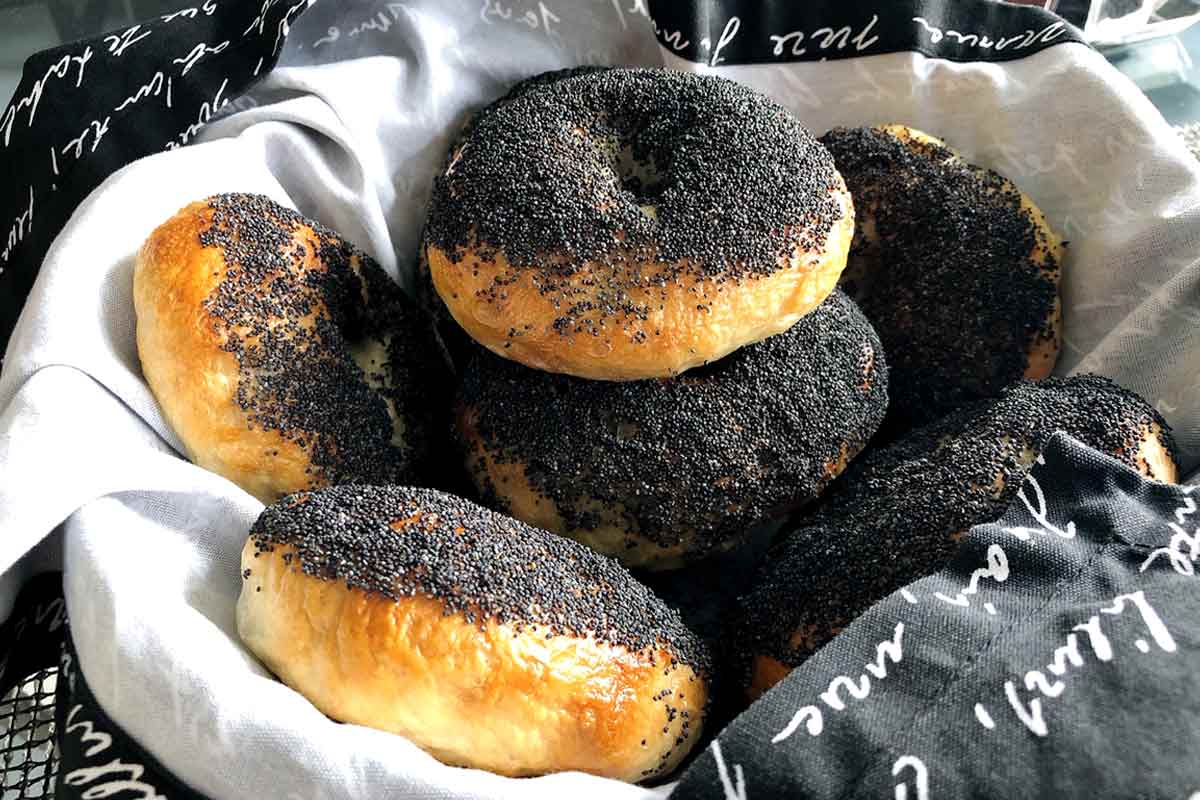
Want to Save This?
These pleasantly chewy, subtly sourdough-y bagels are a fixture on the menu at Flour Girl Bread Co., the Ontario-based home microbakery of one of our recipe testers, Daniela Trapani. Her recipe is adapted from one by Emilie Raffa that appears in Artisan Sourdough Made Simple.–David Leite
☞ LEARN MORE, READ: HOW TO DRY SOURDOUGH STARTER

Sourdough Bagels
Ingredients
- 1 cup plus 2 teaspoons cool water (64°F | 18°C)
- 5 1/4 ounces active starter (100% hydration)
- 2 tablespoons granulated sugar
- 18 ounces all-purpose or bread flour
- 2 teaspoons fine sea salt
- Nonstick vegetable cooking spray
- 1 tablespoon plus 1 teaspoon honey
- Seeds for topping (poppy, sesame, or everything spice mix)
Instructions
- In a large bowl, combine the water and the starter. Add the sugar and mix until everything has dissolved.
☞ TESTER TIP: To make sure your starter is active and ready to go, test a teaspoonful of it in your water before adding the remaining starter and sugar. The starter should float. If not, try feeding your starter and waiting before proceeding with the recipe.
- Add the flour and salt and mix together. Use a Danish dough whisk or wooden spoon to combine until you have a dough-like situation and then use your hands to mix until the flour is completely incorporated. The final dough temperature should be 74°F (23°C).
- Cover the bowl with a lid or damp cloth and let it rest at room temperature until doubled in size, 8 to 10 hours or overnight.
☞ TESTER TIP: If your room temperature is on the cooler side, try letting your dough rise inside a turned-off oven with the light bulb turned on. And if you've dried your starter, here's how to revive it.
- Line a rimmed baking sheet with parchment paper and lightly coat it with cooking spray.
- Using a spatula or flexible bench scraper, gently coax the dough onto a floured surface. The dough will have a web-like appearance. Divide the dough into eight 4-ounce (115 g) portions.
- Shape each piece of dough into a tight ball by gathering all the ends and rolling it into a ball shape, cupping the ball with your hand and moving it in a circular motion to tighten the ball. If the dough sticks to your hands, dust it with a little flour.
- Place the dough balls on the prepared baking sheet and cover with plastic wrap. Let rest at room temperature for 30 to 45 minutes.
- Preheat the oven to 425°F (218°C).
- Bring a large pot of water to a boil. Add the honey and stir to dissolve. Prepare small bowls containing whichever seeds you want for topping.
- Working with 1 ball of dough at a time, use your thumb to gently poke a hole through the center of the dough. Insert both index fingers in the hole and gently stretch and spin to create a hole the size of a walnut. Repeat with the remaining dough.
- Carefully drop 2 to 3 bagels into the boiling water. Simmer for 30 seconds on each side. Using a slotted spoon, drain the bagels and transfer them back to the baking sheet. Let the bagels cool for 30 seconds so that you can handle them. While they’re still wet, dip the bagels into the seeds to coat and return them to the baking sheet. Finish boiling and coating the remaining bagels.
- Bake the bagels until golden and shiny, 22 to 25 minutes, rotating the tray once halfway through baking.
- Transfer the bagels to a baking rack to cool for 5 minutes. The sourdough bagels are best enjoyed warm on the day they’re made. Leftovers can be sliced, frozen, and reheated in the toaster.

An LC Original
View More Original RecipesNutrition
Nutrition information is automatically calculated, so should only be used as an approximation.
Recipe Testers’ Reviews
In our house we LOVE bagels and finding a recipe that incorporates sourdough into an already loved food is always a great thing. The ease of this recipe was also a huge plus in my book as, unlike many sourdough recipes, it didn’t require much “babysitting.” It DOES take several hours because of rise time, but it’s mostly hands off.
These bagels had the great chew of a true bagel with the nice browning of a baked bagel and the slight tang from the sourdough. My husband and I loved them with “everything bagel” seasoning from Trader Joe’s and my kids loved them plain with butter or peanut butter. All in all a big hit and one I will make again in the near future.
This made 8 nice size bagels. Could possibly be made smaller for appetizer-size bagels.
I used bread flour in mine because that’s what I have more of and I also prefer the texture of baked goods with bread flour versus regular. I proof all my doughs in my oven with just the oven light on, which seems to be a perfect environment for them and did the same with this dough. I let it rise for just 7 hours in that spot and it was perfectly doubled and “webby” in appearance at that point. I utilized the “cupping” method for creating the balls of dough and they were beautiful resting on the countertop.
I was pleasantly surprised not to see a baking soda bath for these bagels, which didn’t negatively impact the texture of the finished product. Most bagel recipes I have used in the past have utilized that as their means to “chew” and did not find that lacking without that step. The honey seemed to have given it a nice golden browning but I wonder if malt powder (which I have on hand) would also do the same (and is cheaper than honey!)
After the quick boil and 1 minute cooling, I dipped half the bagels into “everything bagel” seasoning and left the other half plain (kids choice). They baked for exactly 24 minutes and were perfectly golden brown at that point.
I made these in the evening so we waited until the following morning to give them a try and they were delicious! So good, in fact, the my husband was asking me when I could make them again before we were even done eating them! We sliced them in half and then toasted the cut side under the broiler (so as not to get the topping mixture in the toaster!) and then topped them with cream cheese, capers, and lox. Delicious! My two children had their plain bagels toasted with peanut butter and butter on them and also loved them. All in all, this was a definite hit and one that will for certain be repeated in our house!
In a word…wow! As a native New Yorker, I take my bagels quite seriously and these did not disappoint. I have a sourdough starter in my fridge at all times as a result of the pandemic sourdough frenzy and I was so happy to put it to use on this recipe. I started with some angst as my starter didn’t seem active enough based upon the “float” test, but I gave it a feeding, waited a few hours, and proceeded with this utterly simple recipe. Woke up on Sunday and followed the directions and by 8:30 am my house smelled like the local bagel shop, no social distancing necessary and no long lines to conquer.
I had my doubts, after all I like lots of details in my recipes and I had no idea if I should use my Kitchen-Aid or not, or how long to mix the dough, or if I could accomplish this without a Danish dough whisk. I definitely was overthinking. These were easy and delicious.
I made these with all-purpose flour. I loved the temperature guides and ended up putting ice in my water to get it to 64°F and mixed my dough in the Kitchen-Aid with the dough hook until it was well mixed…my dough was 74°F. By morning, the dough had doubled in size.
Perfectly to the wet bagels. I baked them for 25 minutes, I wanted them to have some serious color on the outside. I got 8 perfect bagels. I sliced the leftovers and froze them but have not yet eaten any of those. I am confident that, toasted, they will be perfect.
I buy sheets of parchment from King Arthur and find that they are very sturdy and easily withstood the dough resting on the sheet, followed by wet bagels on the sheet, and then baking on the same sheet. I used Everything Bagel topping from Trader Joe’s for some and used sesame seeds left in the bags of sesame pretzels that I buy, which gave a salty nutty taste to the sesame seed bagels.
This was actually one of the most satisfying recipes that I have ever made.
Is there anything more satisfying than watching buoyant dough in effervescent honey water?! Probably. But the process for making bagels is right up there on the list of great satisfactions! I can’t believe it’s taken me to my 6th decade to consider making bagels. In my mind, this was an activity left for bakeries because the need to boil the dough was just too fussy for home baking. Turns out the boiling of the dough is my favorite part!

This was only my second time making bagels. My first time left me with a great quick yeast bagel recipe that made me feel like a pro, and introduced me to the fun of bagel making. This recipe interested me because of the sourdough component. I’m always looking for new uses for my sourdough discard and so I was very excited to try this. Since I was only getting 8 bagels out of this recipe and I wanted enough to freeze, I also made my quick yeast recipe on the same day. This gave me a chance to truly compare the flavors and textures of both doughs. While this recipe requires 8 to 10 hours for proofing, the actual hands-on time was the same for both the sourdough and the quick yeasted bagel version.
Esther, my starter, did not disappoint! It floated in the water in the initial step and 10 hours later, when I got to it after a good night sleep, it was puffy and doubled in size. This was quite a sticky dough but using a dusting of flour and my trusty silicone mats, I was able to tame the dough balls into bagel shapes and drop them into the honey water. Have I mentioned how satisfying it is to watch bagels float in honey water?! I even watched them grow! What a spectacle! They boiled 30 to 40 seconds per side as I had a large pot and cooked them in 2 batches and couldn’t rescue them fast enough.
In my oven, these were done in 22 minutes. The tops and bottoms were golden and shiny and the internal temperature was 197°F. As for the crumb, all the loved elements of a hearty sourdough bread were present in the bagel. Plus, the loved elements of a bagel, more specifically the chewiness, was also present. They were awesome on day one and later, after being frozen and then toasted. However, this sourdough bagel was still bouncy and chewy awesome in its fresh state the following day, whereas the yeast bagel was hard and required toasting to revive its texture.
Yup! This is a winner bagel recipe! Can’t wait to make these again! 2 batches of sourdough!
I followed all instructions the first time around exactly. The bagels came out dense, as though they hadn’t risen enough. Having never made bagels before and not knowing anything about the process I decided to do some research. For my second bake, I made the dough in the morning, about 10:30, and at 7:00 that evening I started to form and bake the bagels. So the dough had about 8 ½ hours to rise. It did look doubled in size, but didn’t seem that puffy. I proceeded with forming the dough into 4 oz. balls, let them rest for 20 minutes, and then formed the bagels, baked and boiled them.
Second bake: I made the dough at 8:00 night, after I checked to make sure my starter passed the float test. I got started in the morning about 7:30 forming the dough. I could tell right away that the dough looked puffier than my first batch, this was after an almost 12-hour overnight rise. So far so good. I formed the dough into balls. This part of her recipe was spot on, 8 dough balls at 4 oz. each. Instead of following her instructions to let the dough sit for 20 minutes, I let the dough sit for 45 minutes. I went ahead after that period of time and formed the bagels. At this point, I took the advice of Peter Reinhart, and actually checked to see if the bagels were ready yet by making sure they passed the float test. I dropped one bagel into a bowl of cold water, and she went straight to the bottom of the bowl. Ooops, need some more time to rise. After another half hour I tried the float test again, she passed! Now I felt pretty confident that I would have a good result. I simmered the bagels for 40 seconds on each side, then coated with everything bagel seasoning. I baked them for 25 minutes, rotating the tray halfway through, and I also doubled the tray to prevent overbrowning on the bottom of the bagel. This second time produced company-worthy bagels, and in fact I served them at a special birthday lunch, and requests for the recipe are incoming!
I also used everything bagel seasoning, that I shook out of the jar. I felt that this was far easier than trying to handle a wet, slippery bagel; it kept my fingers free of the seasoning mix, and kept the seasoning from becoming wet and clumping up in the bowl.












I’ve had my eye on this recipe for a while. I finally gave it a try when the jonesing for some tasty bagels finally became unbearable! We are big fans of chewy bagels and we make our own sourdough loafs weekly. I’m a of fan of no-knead recipes, so I mixed it up and let it rest overnight. The next morning the dough had risen nicely. The forming and boil process is simple enough, and I topped them with poppy seeds, David’s Everything Bagel Seasoning mix and some course Alaskan sea salt. So far we’ve enjoyed the poppy seeds and EBS topped bagels. They toasted up wonderfully, and we filled one with cream cheese and another one with a sausage patty and cheddar cheese. They make a killer breakfast sandwich! We had to stuff the rest in the freezer for the weekend or else we would demolish them off too quickly!
Wonderful, Craig! We’re so glad you’re enjoying them and we so appreciate you taking the time to comment.
I love baking sourdough bread, but for some reason I always thought bagels would be a lot more complicated. I was wrong – these couldn’t have been any easier! When my sister called to ask me what I was making for dinner I had just pulled my gorgeous sourdough everything bagels from the oven, so I decided on the spot: breakfast for dinner! Everything bagels with cream cheese, capers, red onion, a fat, juicy heirloom tomato from the garden and smoked salmon. These were worth every gram of carbs! A slight tang from the sourdough, authentic chewiness and a nice shiny crust below the everything seed mixture!
My house was a bit warm so my dough proofed in less than the 8-10 hours mentioned in the recipe. Mine doubled in 6 hours. Remember to go by the look and temperature of the dough, not necessarily the time. It can vary depending on how active your starter is, how warm your starting water was, and how warm your house temperature is.
Thanks, Erin! I’m delighted that this was such a success for you. Thanks so much for taking the time to share your experience with us.